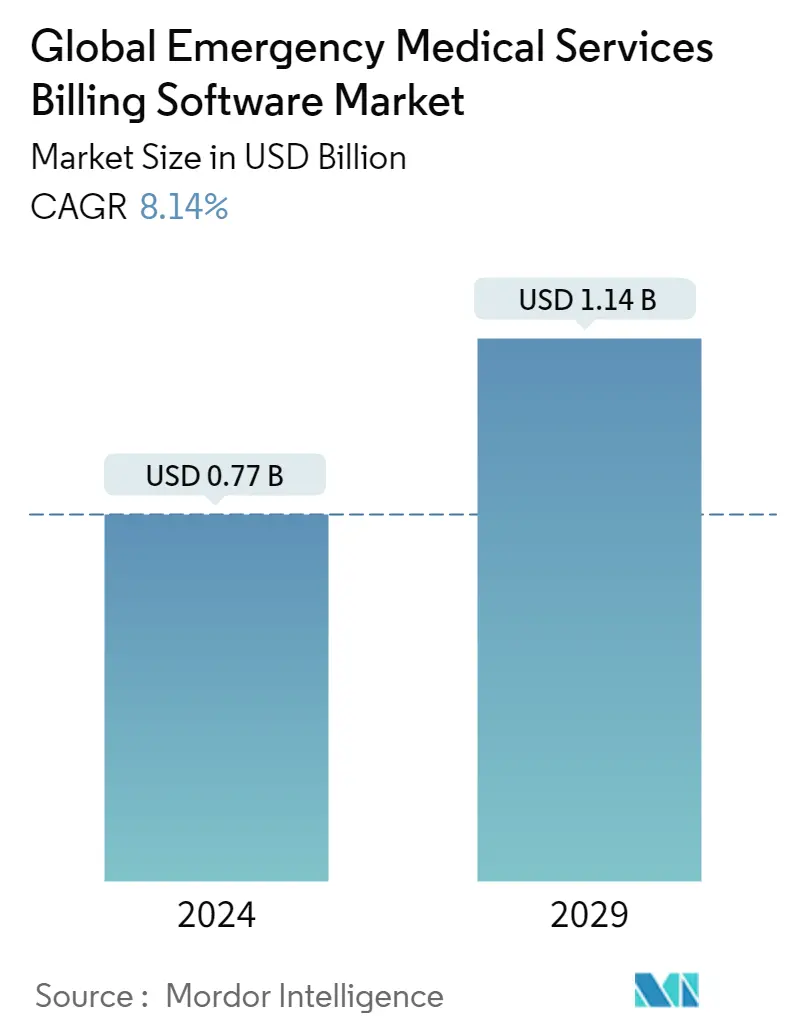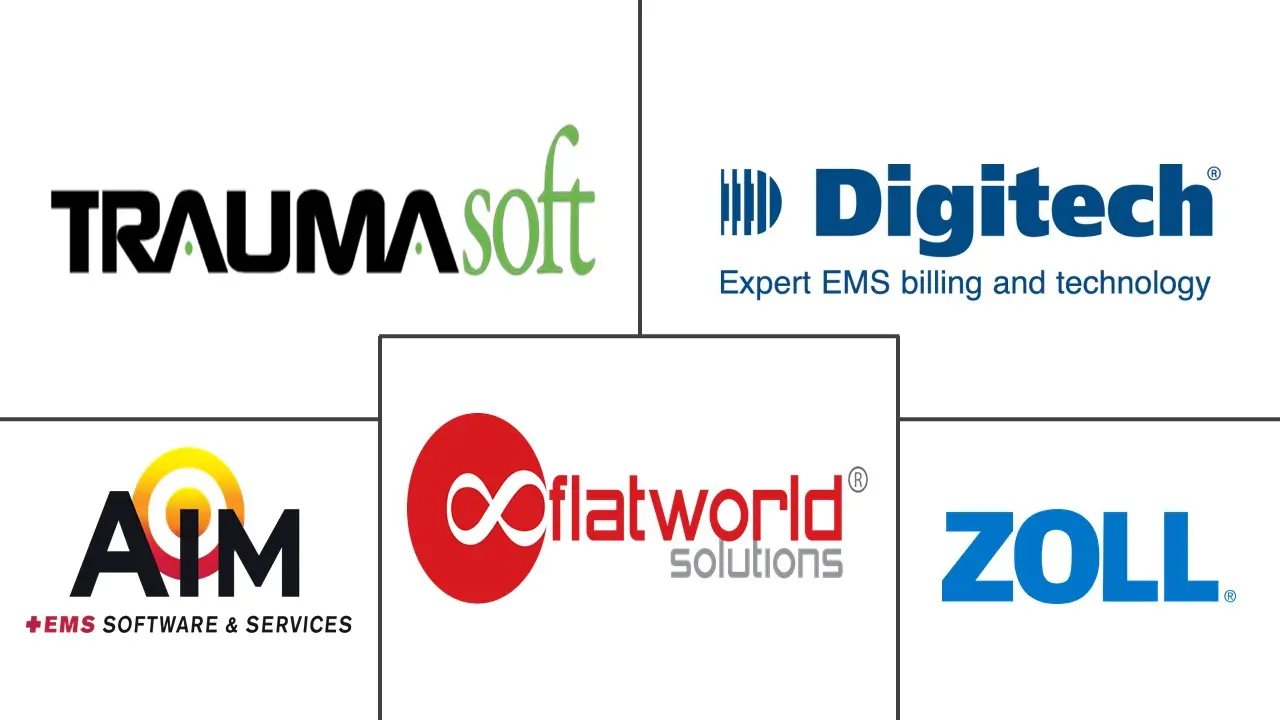Market Size of Global Emergency Medical Services Billing Software Industry

| Study Period | 2019 - 2029 |
| Market Size (2024) | USD 0.77 Billion |
| Market Size (2029) | USD 1.14 Billion |
| CAGR (2024 - 2029) | 8.14 % |
| Fastest Growing Market | North America |
| Largest Market | Asia-Pacific |
| Market Concentration | Medium |
Major Players
*Disclaimer: Major Players sorted in no particular order |
Emergency Medical Services Billing Software Market Analysis
The Global Emergency Medical Services Billing Software Market size is estimated at USD 0.77 billion in 2024, and is expected to reach USD 1.14 billion by 2029, growing at a CAGR of 8.14% during the forecast period (2024-2029).
The pandemic of COVID-19 is expected to have a positive impact on market growth. One of the most important differentiators in today's healthcare systems, including earlier localized healthcare systems, is technology. The COVID-19 pandemic has accelerated digital development, which is expected to have a significant positive impact on the market under consideration. The need for proactive action and the establishment of a robust, collaborative, scalable, and agile digital healthcare infrastructure has been emphasized by the pandemic situation. As a result, many businesses are developing a new strategy that includes digitization and outsourcing non-core functions such as EMS billing and accounts, which is expected to boost the market's growth. During the pandemic phase, there was a noticeable shift toward EMS billing software, which is expected to continue to grow over the coming years.
The strategic initiatives taken by the market players to expand their geographical presence are also propelling the growth of the market. For instance, in November 2021, MP Cloud Technologies/MTech, a cloud-based emergency medical services software and billing company, stated its plans to open a division in Spartanburg County, Columbia. MP Cloud Technologies/MTech provides cloud-based software solutions and revenue cycle management (RCM) to support hundreds of private and municipal emergency medical service providers across the United States.
Furthermore, the increasing number of hospital admissions in emergency departments is also expected to contribute to the growth of the market. For instance, as per the Canadian Institute of Health Information Report titled "Injury and Trauma Emergency Department Hospitalization Statistics, 2020-2021", there are 301,347 females and 249,872 males admitted to the emergency department due to unintentional falls during 2020-2021 in Canada. Such a high number of admissions creates the need for automated and accurate billing software and is thus expected to propel the growth of the market.
Thus, all the aforementioned factors are expected to drive the market for emergency medical services billing software over the forecast period. However, cybersecurity threats to EMS billing software and biased outcomes from in-house billing are some of the factors anticipated to hinder the market's growth.
Emergency Medical Services Billing Software Industry Segmentation
As per the scope of the report, the EMS billing software is designed to provide managers and billers with the tools they need to easily manage the cash flow in an increasingly difficult healthcare billing market. The billing software uses a complicated algorithm to pre-evaluate the data on claims before being sent out. The Emergency Medical Services Billing Software Market is Segmented by Component (In-house and Outsourced), Type (Land Ambulance Services, Air Ambulance Services, Water Ambulance Services), and Geography (North America, Europe, Asia-Pacific, and Rest of the World). The report offers the value (in USD million) for the above segments.
| By Component | |
| In-house | |
| Outsorced |
| By Type | |
| Land Ambulance Services | |
| Air Ambulance Services | |
| Water Ambulance Services |
| Geography | ||||||||
| ||||||||
| ||||||||
| ||||||||
| Rest of the World |
Global Emergency Medical Services Billing Software Market Size Summary
The emergency medical services billing software market is poised for significant growth, driven by the increasing digitization and technological advancements in healthcare systems. The COVID-19 pandemic has acted as a catalyst, accelerating the adoption of digital solutions and emphasizing the need for robust healthcare infrastructure. This shift has led to a greater reliance on EMS billing software, as organizations seek to streamline operations by outsourcing non-core functions. The strategic expansion efforts by key market players, such as MP Cloud Technologies/MTech, further underscore the growing demand for cloud-based solutions to support emergency medical service providers. Additionally, the rising number of hospital admissions, particularly in emergency departments, highlights the necessity for automated and accurate billing systems, contributing to the market's expansion.
In North America, the transformation of the healthcare sector into a data-intensive industry has spurred the adoption of innovative software solutions, driven by increased healthcare spending and proactive government initiatives. The need to reduce billing errors has further fueled the demand for EMS billing software. Strategic initiatives, including partnerships and product innovations, have also played a crucial role in market growth. The competitive landscape is characterized by the presence of both small and mid-sized companies, alongside global players, all vying for market share. Companies like Digitech Computer, Inc., MP Cloud Technologies, and R1 RCM, Inc. are at the forefront, leveraging advancements in technology to enhance their offerings and capture a substantial share of the market.
Global Emergency Medical Services Billing Software Market Size - Table of Contents
-
1. MARKET DYNAMICS
-
1.1 Market Overview
-
1.2 Market Drivers
-
1.2.1 Outsourced Billing Services Maximize Revenue
-
1.2.2 Technology Driven Solution Improved the Efficiency
-
1.2.3 Enhanced the Accuracy of EMS billing Records
-
-
1.3 Market Restraints
-
1.3.1 Cybersecurity Threat for EMS Billing Software
-
1.3.2 Biased Outcomes From In-House Billing
-
-
1.4 Porter's Five Forces Analysis
-
1.4.1 Threat of New Entrants
-
1.4.2 Bargaining Power of Buyers/Consumers
-
1.4.3 Bargaining Power of Suppliers
-
1.4.4 Threat of Substitute Products
-
1.4.5 Intensity of Competitive Rivalry
-
-
-
2. MARKET SEGMENTATION (Market Size by Value USD million)
-
2.1 By Component
-
2.1.1 In-house
-
2.1.2 Outsorced
-
-
2.2 By Type
-
2.2.1 Land Ambulance Services
-
2.2.2 Air Ambulance Services
-
2.2.3 Water Ambulance Services
-
-
2.3 Geography
-
2.3.1 North America
-
2.3.1.1 United States
-
2.3.1.2 Canada
-
2.3.1.3 Mexico
-
-
2.3.2 Europe
-
2.3.2.1 Germany
-
2.3.2.2 United Kingdom
-
2.3.2.3 France
-
2.3.2.4 Italy
-
2.3.2.5 Spain
-
2.3.2.6 Rest of Europe
-
-
2.3.3 Asia-Pacific
-
2.3.3.1 China
-
2.3.3.2 Japan
-
2.3.3.3 India
-
2.3.3.4 Australia
-
2.3.3.5 South Korea
-
2.3.3.6 Rest of Asia-Pacific
-
-
2.3.4 Rest of the World
-
-
Global Emergency Medical Services Billing Software Market Size FAQs
How big is the Global Emergency Medical Services Billing Software Market?
The Global Emergency Medical Services Billing Software Market size is expected to reach USD 0.77 billion in 2024 and grow at a CAGR of 8.14% to reach USD 1.14 billion by 2029.
What is the current Global Emergency Medical Services Billing Software Market size?
In 2024, the Global Emergency Medical Services Billing Software Market size is expected to reach USD 0.77 billion.

